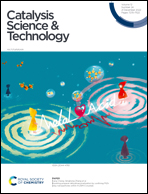Computational identification of bifunctional metal-modified ZSM-5 catalysts to boost methane–methanol coupling†
Abstract
The C–H bond activation of methane, the activation of methanol via dehydration, and methane–methanol coupling to ethylene over bifunctional metal-modified ZSM-5 catalysts were systematically investigated by density functional theory (DFT) calculations to clarify the potential roles of the introduction of methanol and the mechanism of methane–methanol coupling. Energetically favorable pathways of reactant activation and methane–methanol coupling to ethylene over M/ZSM-5 catalysts (M = Zn, Ga, Cu) are identified, and the Zn/ZSM-5 catalyst was found to exhibit superior activity for both reactant activation and C–C coupling. Comparative calculations on the C–C coupling in the absence of methanol versus methane–methanol coupling reveal that the introduction of methanol effectively promotes methane conversion due to the important role of the formed Ofra–CH3 species from methanol dehydration. The co-adsorption of H2O produced from methanol dehydration has little effect on C–C coupling and dehydrogenation to form ethylene. The present DFT results predict that adding Co, Ni, or Pd into Zn/ZSM-5 could promote this reaction due to the reduced C–C coupling barriers on these bimetallic combinations, thus becoming promising candidates for direct methane–methanol coupling.



 Please wait while we load your content...
Please wait while we load your content...